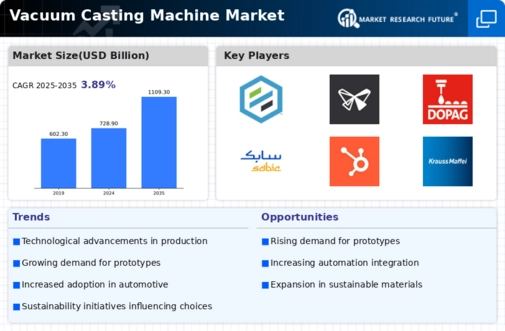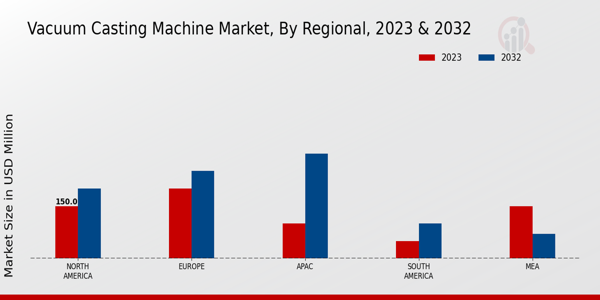Market Growth Projections
The Global Vacuum Casting Machine Market Industry is poised for substantial growth, with projections indicating a market size of 728.9 USD Billion in 2024 and an anticipated increase to 1109.3 USD Billion by 2035. This growth trajectory reflects the increasing adoption of vacuum casting technologies across various sectors, driven by advancements in manufacturing processes and rising demand for customized solutions. The market is expected to experience a compound annual growth rate (CAGR) of 3.89% from 2025 to 2035, highlighting the industry's resilience and adaptability in meeting evolving consumer needs. These figures underscore the potential for investment and innovation within the vacuum casting sector.
Growth in End-User Industries
The Global Vacuum Casting Machine Market Industry is significantly influenced by the expansion of end-user industries such as automotive, healthcare, and electronics. As these sectors continue to grow, the demand for high-quality components and prototypes increases correspondingly. For example, the automotive industry relies on vacuum casting for producing intricate parts that require high precision and durability. This trend is expected to persist, with a compound annual growth rate (CAGR) of 3.89% anticipated from 2025 to 2035. The continuous evolution of these industries necessitates the adoption of advanced manufacturing technologies, thereby propelling the growth of the vacuum casting market.
Increasing Focus on Customization
Customization has emerged as a critical driver in the Global Vacuum Casting Machine Market Industry, as businesses seek to differentiate their products in competitive markets. Vacuum casting allows for the production of tailored components that meet specific customer requirements, enhancing product appeal and marketability. This trend is particularly evident in sectors such as consumer goods and medical devices, where personalized solutions are increasingly demanded. The ability to create unique designs and functionalities through vacuum casting not only satisfies consumer preferences but also fosters brand loyalty. Consequently, this growing emphasis on customization is likely to stimulate market growth in the coming years.
Rising Demand for Prototyping Solutions
The Global Vacuum Casting Machine Market Industry experiences a surge in demand for rapid prototyping solutions across various sectors, including automotive, aerospace, and consumer electronics. Companies are increasingly adopting vacuum casting technology to produce high-quality prototypes that closely resemble final products. This trend is driven by the need for faster product development cycles and reduced time-to-market. As a result, the market is projected to reach 728.9 USD Billion in 2024, reflecting a growing reliance on advanced manufacturing techniques. The ability to create intricate designs with precision further enhances the appeal of vacuum casting, positioning it as a vital tool in modern manufacturing.
Sustainability and Environmental Considerations
Sustainability is becoming a central theme in the Global Vacuum Casting Machine Market Industry, as manufacturers strive to reduce their environmental footprint. The adoption of eco-friendly materials and processes is gaining traction, driven by regulatory pressures and consumer preferences for sustainable products. Vacuum casting processes can be optimized to minimize waste and energy consumption, aligning with global sustainability goals. Companies that prioritize environmentally responsible practices are likely to gain a competitive edge in the market. As sustainability continues to shape industry standards, the vacuum casting market is expected to adapt, fostering innovation and growth.
Technological Advancements in Casting Processes
Technological innovations in the Global Vacuum Casting Machine Market Industry are pivotal in enhancing the efficiency and effectiveness of casting processes. The introduction of automated systems and advanced materials has led to improved production rates and reduced operational costs. For instance, the integration of computer-aided design (CAD) and computer-aided manufacturing (CAM) technologies facilitates precise control over the casting process, resulting in higher quality outputs. These advancements not only streamline operations but also contribute to sustainability efforts by minimizing waste. As the industry evolves, the adoption of such technologies is likely to drive market growth, with projections indicating a market size of 1109.3 USD Billion by 2035.















